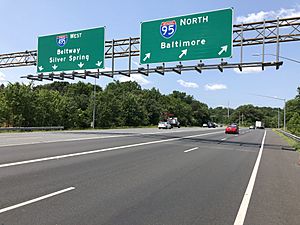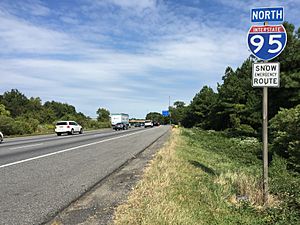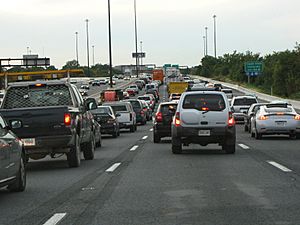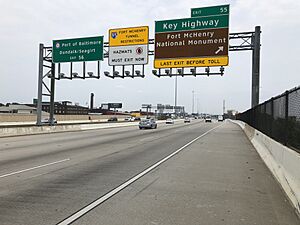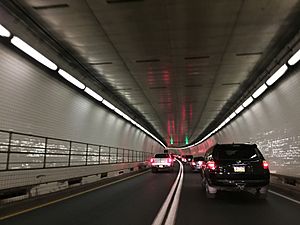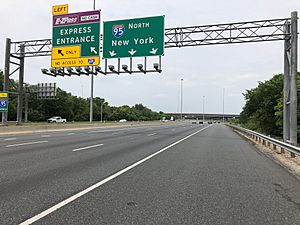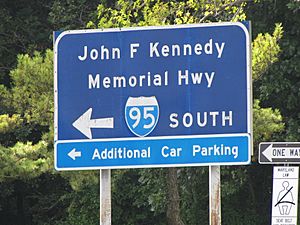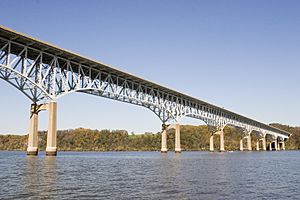Interstate 95 in Maryland facts for kids
Quick facts for kids
Interstate 95 |
||||
|---|---|---|---|---|
|
I-95 highlighted in red
|
||||
| Route information | ||||
| Maintained by MDSHA and MDTA | ||||
| Length | 110.01 mi (177.04 km) | |||
| Existed | 1963–present | |||
| Tourist routes |
||||
| Restrictions | No hazardous goods allowed in the Fort McHenry Tunnel | |||
| Major junctions | ||||
| South end | ||||
| North end | ||||
| Location | ||||
| Counties: | Prince George's, Howard, Baltimore, City of Baltimore, Harford, Cecil | |||
| Highway system | ||||
| Main route of the Interstate Highway System Main • Auxiliary • Business Maryland highway system
|
||||
Interstate 95 (I-95) is a major highway that runs along the East Coast of the United States. It stretches all the way from Miami, Florida, up to the Canadian border in Houlton, Maine. In Maryland, I-95 is a very important road. It travels about 110 miles (177 km) diagonally across the state.
I-95 enters Maryland from Washington, D.C. and Virginia over the Woodrow Wilson Bridge. It then goes northeast to the Delaware state line near Elkton. This is the longest Interstate highway in Maryland. It is also one of the busiest, especially between Baltimore and Washington, D.C. Even with other roads like the Baltimore–Washington Parkway nearby, I-95 is still very popular. Maryland has eight smaller Interstate routes that connect to I-95, which is more than any other state along the I-95 path. Some parts of I-95, like the Fort McHenry Tunnel and the Millard E. Tydings Memorial Bridge, require a toll to use.
From the Woodrow Wilson Bridge to College Park, I-95 shares its path with a part of the Capital Beltway. This section was finished in 1964 and became I-95 in 1977. Before 1977, I-95 was supposed to go through Washington, D.C. However, people protested, and that plan was canceled. The section of I-95 north of the Capital Beltway to Baltimore was built in different steps between 1964 and 1985. The part from Baltimore to Delaware, called the John F. Kennedy Memorial Highway, was the first to open in 1963. Since 2006, this section has been updated. As of 2025, several miles of express toll lanes have been added north of Baltimore. More widening is planned up to the Delaware state line.
Contents
- Exploring I-95 in Maryland
- Roadside Services on I-95
- History of I-95 in Maryland
- I-95 Exit List in Maryland
- Connecting Interstate Routes
Exploring I-95 in Maryland
The Capital Beltway Section
I-95 enters Maryland joined with I-495, which is known as the Capital Beltway. These roads have five lanes in each direction. They cross the Potomac River on the Woodrow Wilson Bridge. They briefly pass over a small part of Washington, D.C., before reaching Prince George's County.
Right away, I-95/I-495 meet I-295, also called the Anacostia Freeway. This road goes to downtown Washington, D.C. Soon after, they connect with Maryland Route 210 (MD 210).
The two Interstates continue on the Capital Beltway. They connect with other local roads like MD 5 and MD 4. These connections are near Andrews Air Force Base. The beltway then turns north through Glenarden. Here, it meets roads like MD 202, US 50, and MD 450. MD 450 provides access to the New Carrollton station, which has train services.
Turning northwest, the beltway enters Greenbelt Park. It crosses the Baltimore–Washington Parkway (MD 295). After that, it connects with MD 201. Now heading west, the beltway goes through College Park. It connects to the Greenbelt station and US 1.
After the US 1 connection, I-95 separates from I-495 at the College Park Interchange. I-495 continues west on the Capital Beltway. I-95 turns north onto its own path. This interchange also has a park and ride lot and a weigh station. It is known as exit 27 for both Interstates.
From Beltsville to Baltimore
Heading northeast, I-95 is eight lanes wide. It passes through Beltsville, connecting with MD 212. This part of the highway was finished in 1971. It goes through undeveloped areas.
I-95 then connects with the Intercounty Connector toll road (MD 200). It also meets Konterra Drive (MD 206) and MD 198 near Laurel. After crossing the Patuxent River, the road enters Howard County. Here, it connects with MD 216. North of this, I-95 has its first rest areas in Maryland, with separate facilities for each direction.
Continuing northeast, I-95 meets MD 32. In this interchange, I-95 lanes cross over or under MD 32. This allows cars to merge smoothly.
North of this, I-95 connects with MD 175. This is the main road to Columbia. Then comes the MD 100 interchange. This exit leads to Ellicott City, US 29, and I-70. It also connects to the Baltimore–Washington Parkway (MD 295) and I-97.
Just after this, I-95 meets three more connecting routes:
- I-895: This road splits from I-95 near the Patapsco River.
- I-195 and MD 166: These roads are near Catonsville. They lead to Baltimore/Washington International Airport.
- I-695: This is the Baltimore Beltway, a road that goes all the way around Baltimore. It connects to I-70, I-83, and I-97.
Before March 2024, large trucks or vehicles carrying dangerous materials used the eastern part of I-695 to cross the Patapsco River on the Francis Scott Key Bridge. After the bridge collapsed, these vehicles now use the western part of I-695. Other traffic can still use I-95 through the city.
When this part of I-95 first opened in 1971, it had tall lights at all interchanges. Since 2010, these have been replaced with shorter, regular streetlights. However, some newer sections and interchanges now have modern tall lights.
Inside Baltimore City
South of Baltimore, I-95 is managed by the Maryland State Highway Administration. Once it crosses into Baltimore city, the Maryland Transportation Authority (MDTA) takes over. I-95 continues northeast, meeting US 1 Alternate. This interchange has leftover parts from a planned highway that was never built.
I-95 then connects with Washington Boulevard, a local street. After that, it meets I-395, which is the main road into downtown Baltimore. I-95 also connects with MD 295 (the Baltimore–Washington Parkway) within the I-395 interchange. This whole area is built high above the Patapsco River. After these connections, I-95 meets MD 2 and Key Highway. Key Highway leads to Fort McHenry and is an alternate route for hazardous materials.
I-95 then enters the Fort McHenry Tunnel south of Fort McHenry. This tunnel has eight lanes and goes under the Northwest Harbor. It comes out in the Canton neighborhood. Here, you'll find an electronic toll plaza. After the toll, I-95 connects with Boston Street and O'Donnell Street. This area also has signs of planned roads that were never built. I-95 passes over I-895 here, but there's no direct connection.
I-95 continues into east Baltimore, connecting to local streets. It meets the Moravia Road freeway spur near the city line. Then it connects with US 40. After this, I-95 narrows to six lanes and merges with I-895 as it leaves Baltimore into northeastern Baltimore County.
Between 2009 and 2015, new gray signs were put up along I-95 in Baltimore. These replaced older brown signs. In 2017, the tall brown light poles were also replaced with new gray ones.
The John F. Kennedy Memorial Highway
The John F. Kennedy Memorial Highway is a toll road run by the MDTA. It starts where the Harbor Tunnel Thruway (I-895) ends, at the Baltimore city line. This section begins with eight lanes. After about 3 miles (4.8 km), I-95 meets I-695 again in Rosedale. This interchange used to be very unusual, with lanes crossing over each other. As part of updates for the express toll lanes, this interchange was rebuilt into a more standard design. All exits are now on the right side.
At this junction, southbound vehicles that cannot use the tunnels (like hazardous materials) are sent onto the western part of I-695. This is because the eastern part was affected by the Francis Scott Key Bridge collapse.
Continuing northeast, I-95 runs next to the Chesapeake Bay. It connects with MD 43 near White Marsh. After passing through Gunpowder Falls State Park and into Harford County, I-95 connects with MD 152 north of Joppatowne. Then it meets MD 24, which leads to Bel Air and Edgewood. Within the MD 24 interchange, I-95 narrows to six lanes and stays this wide to the Delaware border.
Just after the MD 543 interchange, the I-95 lanes spread apart. This creates space for the Maryland House service area, which can be accessed from both directions. After Maryland House, I-95 meets the MD 22 interchange in Aberdeen. This exit provides access to Aberdeen Proving Ground.
South of Susquehanna State Park, I-95 reaches the start of the remaining tolled section. This is at the MD 155 interchange, which leads to Havre de Grace and US 40. (In the past, there were tolls to enter or exit I-95 in Harford County.)
North of this interchange, I-95 becomes a full toll road. It goes through Susquehanna State Park. Then it crosses the Susquehanna River on the Millard E. Tydings Memorial Bridge. This bridge is very high above the river. Signs warn drivers about strong crosswinds. The highway then enters Cecil County. Just after the bridge, there's an electronic toll booth near Perryville. Tolls are only collected for northbound traffic here. There are no southbound tolls. However, southbound trucks might need to stop at a nearby weigh station. After the toll, there's exit 93 for MD 222 in Perryville.
Still running parallel to the northern shore of the Chesapeake Bay, I-95's lanes separate again. This is for another service area called Chesapeake House. It can also be reached from both directions. After passing the northern tip of the bay, I-95 meets MD 272. This exit leads to the towns of North East and Rising Sun. The sign for "North East Rising Sun" has sometimes made people think it's one place!
Turning east, I-95 heads straight for the Delaware state line. It passes under MD 213 near Elkton, but there's no exit. Then it reaches exit 109 for MD 279. This road goes directly to Elkton and Newark, Delaware. I-95's journey through Maryland ends quickly after this exit. It crosses into Delaware and becomes the Delaware Turnpike.
New lighting has been installed at some interchanges, replacing older tall lights with regular streetlights. However, new tall lights were added from the Perryville toll plaza to MD 222.
Express Toll Lanes on I-95
I-95 has special express toll lanes in the middle of the highway. These lanes run from the I-895 merge in northern Baltimore to just north of MD 152 in Joppa. There are two express toll lanes in each direction.
You can enter and exit the express lanes from I-95 at both ends. There are also specific exits and entrances for I-895 and MD 43. These express lanes use all-electronic tolling. This means tolls are collected using E-ZPass or by video tolling. With video tolling, a camera reads your license plate, and a bill is sent to you in the mail. Video tolling costs 50% more.
The cost of using the express lanes changes depending on the time of day and the day of the week. During busy times, like weekday mornings (southbound) or weekday evenings (northbound), the tolls are highest. During less busy times, the tolls are lower, and they are lowest overnight.
Roadside Services on I-95
Just like in Delaware, the northern part of I-95 in Maryland has service areas located in the middle of the highway. These serve traffic going in both directions. This design dates back to when it was a toll highway shared by two states. Between the Delaware line and the Baltimore city line, there are two such service areas. The MDTA owns them, and Areas USA runs them.
Both service areas offer:
- Bus parking
- Free Wi-Fi
- Restrooms
- A Kids Korner seating area
- Outdoor seating
- Several fast-food restaurants
- Retail stores
- Sunoco gas stations
Maryland House Service Area
Maryland House opened in 1963. It is located at milepost 81.9 in Harford County. It was updated in 1987 and expanded in 1989–1990. It closed for a big rebuild on September 15, 2012, and reopened on January 16, 2014. This service area also has a dog park.
Chesapeake House Service Area
Chesapeake House opened in 1975. It is at milepost 97 in Cecil County. It closed and was torn down in January 2014 after Maryland House reopened. It then reopened on August 5, 2014.
Howard County Rest Areas
There are also two rest areas in Howard County, between Baltimore and Washington, D.C. Unlike the service areas further north, these are located on the sides of the road. Each direction of travel has its own facilities. They only offer restrooms, a tourist information area, and vending machines. They do not have food or gas like the larger service areas.
History of I-95 in Maryland
The Northeast Freeway Plan
Originally, I-95 in Maryland was not supposed to follow the eastern part of the Capital Beltway. Instead, it was planned to leave Washington, D.C., at New Hampshire Avenue. It would have followed a road called the Northeast Freeway. This freeway would have connected to I-495 at the College Park Interchange. However, this plan was canceled in 1977. This happened because the D.C. government canceled another planned freeway, the North Central Freeway. The part of I-95 that was built in D.C. and Virginia was then renamed I-395. In 1977, I-95 was rerouted onto the Capital Beltway. In 1991, the I-495 name was added back to the eastern part of the beltway, so it became I-95/I-495.
I-95 Construction in Baltimore
Planning the Route
Many ideas for a highway through Baltimore were discussed in the 1940s and 1950s. In 1960, the city's planning department suggested a route. This route would have gone through city parks and then across the city center on a raised bridge. It would have met other freeways and then followed the Boston Street area out of the city. These early plans would have required tearing down many buildings.
The plans were changed and became part of the Baltimore 10-D Interstate System in 1962. In this plan, I-95 would run east–west north of Fort McHenry. It would pass through historic neighborhoods like Fell's Point. This plan was also not popular.
By 1969, a new plan called the Baltimore 3-A Interstate and Boulevard System was approved. In this plan, I-95 was moved south to the Locust Point area. It was eventually built there. I-95 was originally going to cross the Patapsco River on a very tall bridge. But people opposed this, so the Fort McHenry Tunnel was built instead. This tunnel was the last part of I-95 in Baltimore to be finished. Under this plan, I-95 would go around the city center. I-395 was created to provide direct access to downtown.
Building the Road
The first part of I-95 in Baltimore was a small section of the John F. Kennedy Memorial Highway, finished in 1963. By 1971, I-95 was completed between the Capital and Baltimore beltways. It stopped at US 1 Alternate. By 1974, I-95 was being built in East Baltimore. By 1981, it reached I-395. By 1984, with the Fort McHenry Tunnel almost done, the road was open up to MD 2 on one side and Boston Street on the other. The tunnel finally opened on November 23, 1985. This completed I-95 within Baltimore.
Tolls in Baltimore
The toll plaza at the north end of the Fort McHenry Tunnel was supposed to be removed. This would happen after Baltimore paid back its share of the tunnel's building costs. However, the MDTA successfully argued to keep the toll plaza. They wanted to prevent traffic problems on I-95 in Baltimore.
The John F. Kennedy Memorial Highway History
Even though I-95 was planned in the 1950s, most state money went to building the Baltimore and Capital beltways. To help with traffic on US 40, it was decided to pay for I-95 using special bonds. The Maryland State Roads Commission (now the MDTA) raised $73 million to start building the road in January 1962.
The 48-mile (77 km) Northeast Expressway and the 11-mile (18 km) Delaware Turnpike were finished in 1963. President John F. Kennedy, Delaware Governor Elbert N. Carvel, and Maryland Governor J. Millard Tawes dedicated them on November 14, 1963. Eight days later, President Kennedy was assassinated. So, both roads were renamed the John F. Kennedy Memorial Highway in his honor in December 1963.
From 1963 to 1993, the John F. Kennedy Memorial Highway was a toll road for its entire length in both directions. The main toll plaza is just north of the Millard E. Tydings Memorial Bridge in Perryville. The southbound toll plaza was removed in 1991. However, tolls are still collected for northbound traffic over the bridge at this spot. Also, tolls were collected at many exits until 1981. The MDTA maintains the highway and bridge.
The exits on the John F. Kennedy Memorial Highway were first numbered in order, starting with exit 1. This caused confusion because I-95 in Maryland had different sets of exit numbers. In the mid-1980s, the exits were renumbered based on mileage. Now, they range from exit 2 (I-295 north) on the Capital Beltway to exit 109 (MD 279) on the John F. Kennedy Memorial Highway.
A special connection was built to link the John F. Kennedy Memorial Highway with the Harbor Tunnel Thruway. This meant I-95 had to curve to the right to connect. A project in 2009 fixed this, so I-95 now goes straight through the interchange.
Express toll lanes were built from the I-895 merge in northern Baltimore to just north of MD 43. These lanes opened on December 6, 2014, after more than eight years of building. This was part of a $1.1 billion project to improve I-95. On December 18, 2024, the northbound express toll lanes were extended from MD 43 north to MD 152.
Changes in Road Management
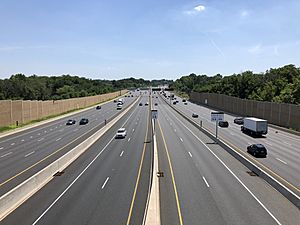
Originally, different parts of I-95 in Baltimore were managed by different groups. The city of Baltimore maintained some sections. The MDTA maintained the part with the Fort McHenry Tunnel.
Now, the MDTA manages all of I-95 between the southern and northern Baltimore city lines. The Maryland state police and the MDTA's own police share duties on this section. The city of Baltimore also pays the MDTA to maintain I-95 within the city limits.
Unfinished Interchanges
I-95 has at least four unfinished interchanges. Three of these are in Baltimore. These are signs of past protests that stopped some highway plans.
The first is the College Park Interchange, exit 27. This was where I-95 and I-495 were supposed to cross, and where the Northeast Freeway would have started. The Northeast Freeway was never built. This left highway lanes ending suddenly. After the plan to build I-95 through D.C. was canceled, I-95 was rerouted onto the Capital Beltway in 1977. The interchange was changed in 1986 to allow smooth traffic flow. Today, all parts of this interchange are used regularly. The southern end now serves as a park and ride lot for commuters.
The other three unfinished interchanges are in Baltimore. They were planned for the ends of I-70, I-83, and the Windlass Freeway. All three include connections to local roads.
- The first is near exit 50. This was where I-70 was supposed to end. You can still see parts of bridges and ramps that were never finished. The shoulders are narrow here, showing where I-95 was once narrower. Today, exit 50 connects US 1 Alternate to I-95.
- The second is near exit 57, just north of the Fort McHenry Tunnel. This was where I-83 was planned to end. Like the I-70 spot, there are unfinished ramps and bridges. This interchange also serves Boston Street and O'Donnell Street. I-83's planned end was canceled in 1982, and I-70's in 1983.
- The third is at exit 60. This was the start of the Windlass Freeway, a planned bypass for US 40. Part of this freeway was built and is now part of I-695. The interchange here is partly used, connecting to the Moravia Road freeway spur. Unfinished ramps show where the rest of the freeway was planned.
Major Incidents on I-95
- On January 13, 2004, a tanker truck carrying flammable liquid crashed from a ramp near I-95. It caused a huge explosion, damaging several cars and killing four people. However, the highway itself was not damaged and reopened the next day.
- On October 16, 2004, a sudden hailstorm near Baltimore caused 33 accidents involving over 130 vehicles. Both northbound and southbound lanes of I-95 were closed for many hours.
- On January 16, 2007, a tired truck driver lost control of a tanker truck near Maryland House. The truck overturned and leaked a dangerous liquid. The road was closed for a while.
- On October 4, 2008, a tanker carrying acetone overturned on I-95 southbound. Both directions of the highway were closed for over eight hours.
Highway Improvements
Because I-95 is used so much, the MDTA has been working to make it bigger. They have divided the expansion plans into smaller sections. In 2001, the MDTA started studying how to best expand the highway.
Section 100 Improvements
Section 100 is an 8-mile (13 km) part of the John F. Kennedy Memorial Highway. It runs between exit 62 (I-895) and milepost 70. This section used to have eight lanes. It carried about 165,000 vehicles per day. This section has been expanded to 12 lanes. The middle lanes are now express toll lanes.
Also, the interchange between I-95 and the Baltimore Beltway at exit 64 was rebuilt. It is now a more standard stack interchange, removing the confusing left turns. The interchange at exit 67 (MD 43) was also changed. The interchange at exit 62 was reconfigured so that I-95 is now the main straight path, instead of I-895.
This project cost $1.1 billion. It started in 2006 and was finished in 2014. As of December 18, 2024, the rest of the section between Exit 67 and milepost 70 has been widened. This extends the northbound express lanes to milepost 77.
Section 200 Improvements
Section 200 is a 15-mile (24 km) part from milepost 70 to exit 85 (MD 22). This section currently has eight lanes up to exit 77 (MD 24), and six lanes between exits 77 and 85. Like Section 100, this part will be widened to 12 lanes up to exit 80 (MD 543). The rest, between exits 80 and 85, will likely be widened to eight lanes. The MD 24 interchange was improved in 2009.
The part between mileposts 70 and 79 is currently being widened. This will extend the northbound express lanes to just south of MD 543. The MD 152 and MD 24 interchanges will be rebuilt. The MD 152 interchange reconstruction involved tearing down a bridge and moving a park-and-ride lot. This project is expected to be finished by 2026. The section between MD 43 and MD 152 was completed and opened on December 18, 2024.
Section 300 Improvements
Section 300 is a 3-mile (4.8 km) part from exit 77 to exit 80. Plans for its widening are part of the Section 200 improvements.
Section 400 Improvements
Section 400 is the longest part, about 30 miles (48 km) long. It goes from exit 80 to the Delaware border. This section has six lanes and will likely be widened to eight lanes. This will require major rebuilding of the Millard E. Tydings Memorial Bridge.
Between the Beltways Study
A study is looking into adding a new lane on each side of I-95 between I-495 and I-695. This would involve creating new inner shoulders and turning the current inner shoulders into special lanes. These lanes would be for vehicles with three or more people, hybrid cars, electric cars, and emergency vehicles.
Proposed Toll Plaza Relocation
The MDTA studied moving the northbound toll booth. It is currently just north of the Millard E. Tydings Memorial Bridge in Perryville. The study concluded that the toll booth should stay where it is. Moving it would cause too much traffic to use local roads in Cecil County. It would also mean less money for the MDTA and more travel on slower, less safe roads.
I-95 Exit List in Maryland
| County | Location | Mile |
Roads intersected | Notes | ||
|---|---|---|---|---|---|---|
| 0.00 | Invalid type: I-Local south / Invalid type: I-Local west (Capital Beltway) – Richmond | Continues into Virginia | ||||
| 0.00– 1.16 |
0.00– 1.87 |
Woodrow Wilson Memorial Bridge Virginia–District of Columbia and District of Columbia–Maryland borders |
||||
| Prince George's | Oxon Hill | 1.73 | 2.78 | 2 | Signed as exits 2A (National Harbor) and 2B (I-295); also exits 1A-C on I-295 | |
| 2.77 | 4.46 | 3 | Signed as exits 3A (south) and 3B (north) northbound | |||
| Northbound exit and southbound entrance for Thru Lanes | ||||||
| 3.50 | 5.63 | — | Invalid type: I-Local south / Invalid type: I-Local west |
North end of Thru Lanes | ||
| 4.33 | 6.97 | 4 | Split into exits 4A (west) and 4B (east) | |||
| Temple Hills | 7.30 | 11.75 | 7 | Split into exits 7A (south) and 7B (north); leads to Branch Avenue station and Metro to Nationals Park via exit 7B | ||
| Morningside | 9.07 | 14.60 | 9 | Northbound exit and southbound entrance | ||
| 9.69 | 15.59 | Southbound exit and northbound entrance; Suitland Parkway not signed | ||||
| Forestville | 10.78 | 17.35 | 11 | Split into exits 11A (south/east) and 11B (north/west) | ||
| Largo | 13.14 | 21.15 | 13 | Ritchie–Marlboro Road (MD 221A) – Upper Marlboro, Capitol Heights | ||
| 14.78 | 23.79 | 15 | Split into exits 15A (east) and 15B (west) southbound; leads to Northwest Stadium | |||
| 15.83 | 25.48 | 16 | Medical Center Drive (MD 202F) | Leads to Northwest Stadium | ||
| Landover | 16.56 | 26.65 | 17 | Split into exits 17A (south) and 17B (north) southbound; leads to Northwest Stadium, Downtown Largo, and Nationals Park via Metro | ||
| Glenarden | 18.54 | 29.84 | 19 | Split into exits 19A (east) and 19B (west); US 50 is also I-595; leads to New Carrollton Station and Nationals Park via Metro from southbound ramp to westbound US 50 | ||
| New Carrollton | 19.59 | 31.53 | 20 | Split into exits 20A (east) and 20B (west) | ||
| Greenbelt | 22.12 | 35.60 | 22 | Baltimore–Washington Parkway (MD 295) – Baltimore, Washington | Split into exits 22A (north) and 22B (south); no commercial vehicles; leads to Nationals Park via Metro | |
| 23.04 | 37.08 | 23 | Leads to MD 193, Goddard Space Flight Center, University of Maryland, SECU Stadium, and Xfinity Center | |||
| 24.25 | 39.03 | 24 | Southbound exit and northbound entrance; no commercial vehicles | |||
| College Park | 25.19 | 40.54 | 25 | Split into exits 25A (north) and 25B (south) southbound | ||
| 26.11 | 42.02 | 27 | College Park Interchange; north end of shared road with I-495; southbound I-95 uses exit 27 to reach exit 25 and the park and ride/weigh station; access road to the park and ride is I-95X | |||
| Beltsville | 28.54 | 45.93 | 29 | Split into exits 29A (east) and 29B (west) | ||
| Laurel | 30.66 | 49.34 | 31-32 | Split into exits 31A (MD 200 east), 31B (MD 200 west) and 32 (Konterra); Muirkirk station accessed via exit 31A; E-ZPass or video tolling on MD 200 | ||
| 32.70 | 52.63 | 33 | Split into exits 33A (east) and 33B (west) | |||
| Howard | North Laurel | 35.26 | 56.75 | 35 | Split into exits 35A (east) and 35B (west) | |
| Savage | 38.18 | 61.44 | 38 | Split into exits 38A (east) and 38B (west) | ||
| Columbia | 40.49 | 65.16 | 41 | Split into exits 41A (east) and 41B (west) | ||
| Elkridge | 42.37 | 68.19 | 43 | Split into exits 43A (east) and 43B (west) | ||
| 45.26 | 72.84 | 46 | Northbound exit and southbound entrance; southern end of I-895 | |||
| Baltimore | Arbutus | 46.50 | 74.83 | 47 | Split into exits 47A (east) and 47B (north) | |
| 48.47 | 78.00 | 49 | Split into exits 49A (east) and 49B (west); I-70 and Annapolis signed southbound; hazardous materials/overheight vehicles must use I-695 western loop | |||
| Baltimore City | 49.76 | 80.08 | 50 | Caton Avenue (US 1 Alt.) | Split into exits 50A (south) and 50B (north) | |
| 50.89 | 81.90 | 51 | Washington Boulevard | Northbound exit and southbound entrance | ||
| 51.67 | 83.15 | 52 | MD 295 north (Russell Street) | Northbound exit and southbound entrance to and from Russell Street | ||
| 51.67 | 83.15 | 52 | Southbound exit and northbound entrance to and from MD 295 | |||
| 52.09 | 83.83 | 53 | Southern end of I-395; leads to Oriole Park at Camden Yards, M&T Bank Stadium, and Baltimore Convention Center | |||
| 52.69 | 84.80 | 54 | Northbound exit and southbound entrance | |||
| 53.45 | 86.02 | 55 | Key Highway (MD 2 Truck) – Fort McHenry National Monument | Last northbound exit before toll | ||
| 54.07– 55.44 |
87.02– 89.22 |
Fort McHenry Tunnel (E-ZPass or video tolling) | ||||
| 55.96 | 90.06 | 56 | Keith Avenue | Last southbound exit before toll | ||
| 56.76 | 91.35 | 57 | Boston Street | Northbound exit and southbound entrance | ||
| 56.99 | 91.72 | 57 | O'Donnell Street | Southbound exit and northbound entrance | ||
| 57.73 | 92.91 | 58 | Dundalk Avenue south | Northbound exit and southbound entrance | ||
| 58.17 | 93.62 | 59 | ||||
| 59.42 | 95.63 | 60 | Moravia Road | Northbound exit and southbound entrance | ||
| 59.84 | 96.30 | 61 | Northbound exit and southbound entrance | |||
| 60.40 | 97.20 | South end of Express Lanes; northbound exit and southbound entrance, E-ZPass or video tolling | ||||
| 60.50 | 97.37 | 62 | Southbound exit and northbound entrance; northern end of I-895 | |||
| Baltimore | Rosedale | Southbound exit and northbound entrance for Express Lanes only; northern end of I-895 | ||||
| 63.38 | 102.00 | 64 | Hazardous materials/overheight vehicles must use I-695 western loop | |||
| White Marsh | 66.60 | 107.18 | 67 | |||
| Northbound exit, southbound & northbound entrances for Express Lanes only | ||||||
| 68.10 | 109.60 | North end of Express Lanes; southbound exit and northbound entrance, E-ZPass or video tolling | ||||
| Harford | Joppatowne | 73.86 | 118.87 | 74 | ||
| Edgewood | 76.19 | 122.62 | 77 | Split into exits 77A (MD 24) and 77B (MD 924 and Tollgate Road) | ||
| Riverside | 79.90 | 128.59 | 80 | |||
| Aberdeen | 84.33 | 135.72 | 85 | Northbound exit includes direct exit ramp to |
||
| Havre de Grace | 88.67 | 142.70 | 89 | Last northbound exit before toll | ||
| Susquehanna River | 90.13– 91.10 |
145.05– 146.61 |
Millard E. Tydings Memorial Bridge (northbound toll; E-ZPass or pay-by-plate) | |||
| Cecil | Perryville | 92.95 | 149.59 | 93 | ||
| Port Deposit | 95 | Belvidere Road | Future interchange | |||
| North East | 99.55 | 160.21 | 100 | Split into exits 100A (south) and 100B (north) southbound | ||
| Elkton | 108.27 | 174.24 | 109 | Split into exits 109A (south) and 109B (north); last northbound exit before toll in Delaware | ||
| 109.01 | 175.43 | Continues into Delaware | ||||
| 1.000 mi = 1.609 km; 1.000 km = 0.621 mi | ||||||
Connecting Interstate Routes
I-95 in Maryland has eight connecting routes. This is more than any other state along the I-95 path:
- I-195: A short road that goes to Baltimore/Washington International Airport.
- I-295: A southern route that leads into Washington, D.C..
- I-395: A short road that goes into downtown Baltimore.
- I-495: This is the Capital Beltway, a loop around Washington, D.C.
- I-595: This is a hidden name for a part of US 50 between the Capital Beltway and Annapolis.
- I-695: This is the Baltimore Beltway, a loop around Baltimore.
- I-795: This road is not directly connected to I-95. It bypasses MD 140 in Reisterstown and Owings Mills.
- I-895: This is the Harbor Tunnel Thruway.



